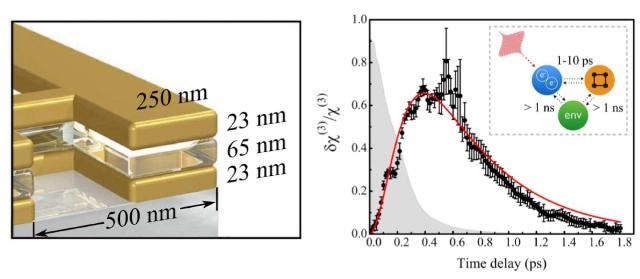Jun 24 2016
Scientists demonstrated the effect of the all-optical switching between streams of photons using non-linear metamaterials.
 This is a schematic illustration of the studied fishnet metamaterial (left). The relative change in the effective third-order nonlinear susceptibility of the fishnet metamaterial as a function of the time delay between the pump and probe pulses (black dots) and its fit to Eq. (7) (red curve). The gray dashed area represents the normalized cross-correlation function of the laser pulses. Inset: illustration of the photoinduced relaxation processes occurring in the structure (right). Credit: Source: Scientific Reports.
This is a schematic illustration of the studied fishnet metamaterial (left). The relative change in the effective third-order nonlinear susceptibility of the fishnet metamaterial as a function of the time delay between the pump and probe pulses (black dots) and its fit to Eq. (7) (red curve). The gray dashed area represents the normalized cross-correlation function of the laser pulses. Inset: illustration of the photoinduced relaxation processes occurring in the structure (right). Credit: Source: Scientific Reports.
The Lomonosov Moscow State University staff planned the whole study, conducted calculations and experiments, while their German colleagues made samples of metamaterials. The work is published in Scientific Reports.
An international team of scientists led by MSU researchers for the first time managed to demonstrate the effect of all-optical switching between streams of photons, born during the third harmonic generation process. According to Maxim Scherbakov, the researcher of the Laboratory of Nanophotonic metamaterials, Moscow State University, the work will make it possible to use the metamaterials to create high-speed communication technologies in future.
Metamaterials: when 1 + 1 = 3
Sometimes, a team of a few people can achieve far more than the sum of their individual achievements would provide, as if, teaming up, they acquire new and useful properties. The same is true for metamaterials. And if in the example of the people in the team, when instead of the simple sum of the known quantities we gain something completely different, the situation is explained by various psychological effects, in the case of metamaterials such 'super-powers' as invisibility (only in microwave range and two-dimensional space, though), seeing through walls, optical zooming and negative refractive index are artificially created by the ordered structure of alternating layers of quite common substances. However, if combined, they behave as a completely new material with unique electromagnetic properties that can manipulate photons, i.e. light, in a new way.
The metamaterials which the authors of the article worked with have fishnet-looking structure with the main 'threads' consisting of gold and magnesium oxide. They belong to a class of nonlinear metamaterials, whose unusual optical properties can be used, for example, to simplify the processing of information and to create new devices that operate much faster than contermporary electronic devices.
Masters of light
Photons, unlike electrons that move through the wires of electronic devices, have no charge and rest mass, so they can perform in formation transfer much faster. There is a problem, though, in developing photonic transistors as compact as modern electronic ones.
For this purpose, metal and semiconductor nanoparticles, microcavities, photonic crystals, and other man-made structures were suggested. A disadvantage of these media is that for observing all-optical switching in them, a powerful laser radiation is required. However, the nonlinear metamaterials, as reported in the article, have a higher sensitivity to femtosecond laser pulses than linear ones, which gives the former an advantage in the management of light flows by the means of these pulses.
'In the conventional all-optical switching devices, one photon flux controls another thread about the same as it happens in electronic transistors with electron flows. In our previous work, we irradiated a silicon nanostructure with two laser pulses, and the transmission of a pulse varied depending on whether the second pulse is present,' says the study co-author, PhD in physical and mathematical sciences Maxim Shcherbakov.
Birth of photons
During the Maxim Scherbakov and his colleagues' work at the Nanophotonics of Metamaterials Laboratory, the experiments demonstrated that photon flow scan control the processes of photon merging with one another.
'There is an interesting effect in optics, that can occur when three photons merge into one with tripled energy -- almost as during thermonuclear fusion. This effect is called the third harmonic generation. In our work, we also (and for the first time, to the best of our knowledge) observed both effects: all-optical switching and third-harmonic generation. In other words, we control the process of photon synthesis with an external optical pulse. It is very important for integrated photonics, where the full control over all possible processes involving light is required,' Maxim Scherbakov notes, emphasizing that the high sensitivity of nonlinear metamaterials allows to use them to create high-speed communications technologies in the future.